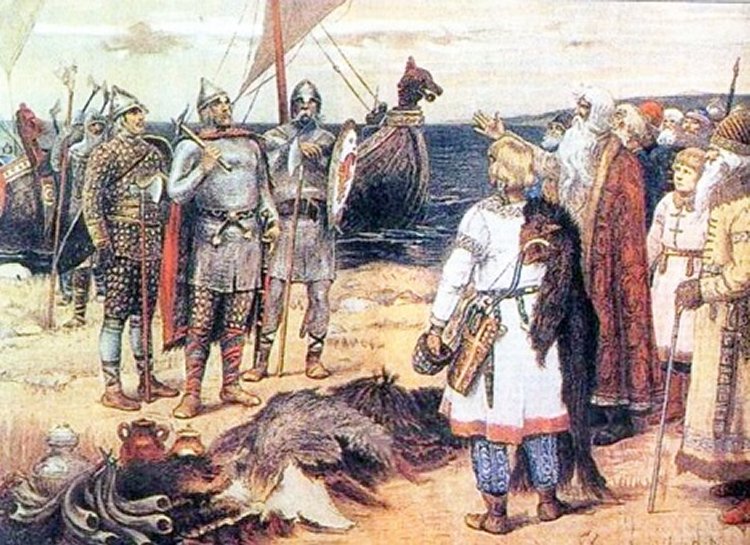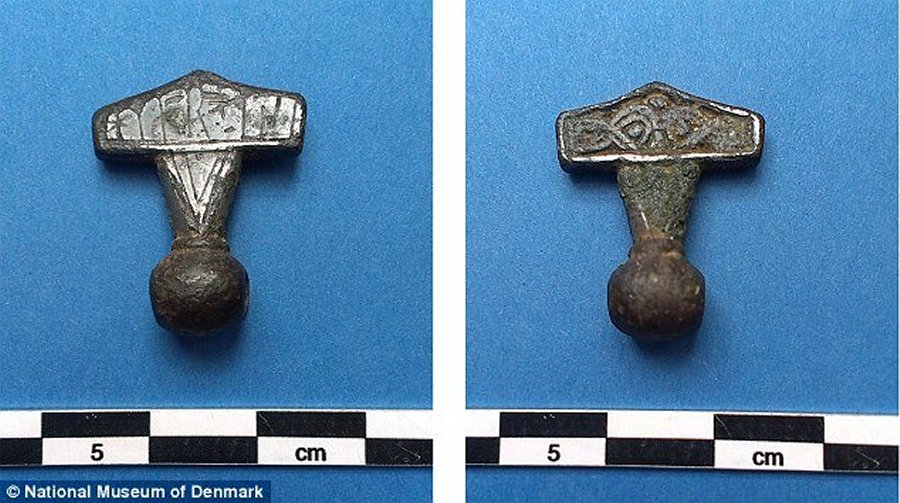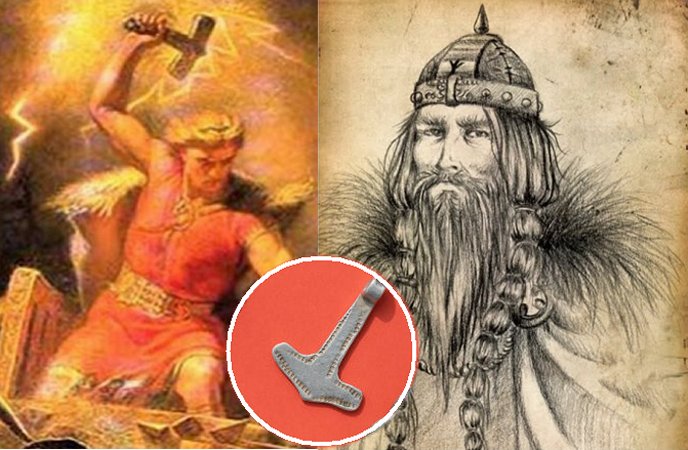Why Did Christian Viking King Harald Bluetooth Carry A Hammer Of Thor Amulet?
Ellen Lloyd - AncientPages.com - An extraordinary Viking treasure connected to King Harald Bluetooth has been found on the island of Rügen in the Baltic Sea in northern Germany.
Wonderful Viking Age necklaces, rings, bracelets, beads, brooches and hundreds of coins were discovered by an amateur archaeologist and a 13-year-old student who were searching the island with a metal detector.
Left: God Thor in Norse mythology - Right: King Harald Bluetooth - Middle: Hammer of Thor amulet discovered in the Baltic Sea - Credit: Stefan Sauer
According to excavation director Michael Schirren, the silver coins are of "outstanding importance” because “similar types of coins have so far only been found in the territory of the Danish empire, such as at Husby and Harndrup”.
More than 600 silver objects were found, and experts say these items date back to the reign of the famous Danish Harald "Bluetooth" Gormsson (910-987).
King Harald Bluetooth Converted Danes To Christianity
Harald Bluetooth was the Viking king of Denmark between 958 and 970. King Harald Blutetooth was famous for uniting parts of Denmark and Norway into one nation and converting the Danes to Christianity.
He was a skilled military and political leader and united the outlying tribes of Denmark.

The Danes were united and Christianized in about 965 by King Harald "Bluetooth" Gormsson (c. 935 to c. 986; King of Denmark c. 958 to c. 986 ; King of Norway c. 970 to 986).
In Bluetooth’s legacy there are so-called “runestones” – monuments that usually honored the dead and their deeds.
Harald Bluetooth wished to be remembered for some specific achievements; therefore, he erected a runic stone intended to last forever.
King Bluetooth is equally known for casting off the Norse pagan traditions and, becoming a devout Christian who strove to peacefully convert the people of Denmark during his rule.
In 965, he erected a runestone in Jelling, with inscription: “Harald who conquered for himself the whole of Denmark and Norway and made the Danes Christian."
Hammer Of Thor – Pagan Amulet Carried By Vikings
Among the artifacts discovered on the island of Rügen was an amulet made in the shape of Mjölnir, known as the Hammer of Thor.
Many readers of Ancient Pages, are familiar with Mjölnir (also known as Miölnir, Mjølne, Mjǫllnr) which was a terrible axe-hammer that belonged to Norse god Thor. The word Mjölnir means ‘crusher’ (or ‘striker’).
In Norse mythology, the Hammer of Thor was a great treasure that protected Aesir gods and their Kingdom Asgard.
Pagan Vikings worshipped god Thor and often carried an amulet made in the image of his famous hammer.

Discovered in 2014, both sides of the Hammer of Thor amulet shown here with runes seen on the left image. Inscribed runes reads 'Hmar x is' (This is a Hammer').
It is not the first time archaeologists discover a Hammer of Thor amulet. Back in 2014, archaeologists, working with the National Museum of Denmark, unearthed an unusual 10th century amulet in Købelev on the Danish island of Lolland. The artifact finally ended the debate how Thor's legend influenced Viking jewelry.
On the artifact inscribed runes read 'Hmar x is' meaning 'This is a Hammer'.
An unknown rune writer confirmed that the amulet depicts Thor's hammer, a lasting symbol of Viking culture. The fact that the person who made the hammer was literate fascinated archaeologists.
Some years ago, archaeologists, working with the National Museum of Denmark, have unearthed the unusual 10th century amulet in Købelev on the Danish island of Lolland that could finally end the debate on how Thor's legend influenced Viking jewellery.
The latest find is unusual as it has runes inscribed that read 'Hmar x is' meaning 'This is a Hammer'.
Double Protection – Vikings Used Pagan And Christian Symbols
The Christian cross is featured on the unearthed silver coins found on the island of Rügen. This is perfectly understandable since King Harald Bluetooth implemented reforms and introduced Christianity to Denmark.
But why was an amulet representing the Hammer of Thor discovered among the other artifacts that are believed to be linked to King Bluetooth?
According to state archaeology office, “it's possible that the hoard wasn't just from Harald Bluetooth's reign, but that it was directly tied to the king himself.”
Would a Christian Viking King Bluetooth carry a typical and significant Norse symbol associated with a Pagan god?
Some of the treasures that were discovered on the island of Rügen. Photo: DPA
One possibility is that the discovered hoard is not tied to King Bluetooth at all. During this time there was a lot of movements and there are many buried treasures in the area. However, the coins’ date seems to indicate scientists have good reasons to link the discovery to King Bluetooth.
Another option is that the Mjölnir amulet did not belong to King Bluetooth, but rather one of his warriors. That too seems unlikely because King Bluetooth promoted Christianity.
See also:
Vikings: Facts And History About The Tough Norse Seafaring People
Secrets Of Viking Crystal Sunstones Revealed By Modern Science
There is a third option that should be considered. According to Peter Pentz, an archaeologist at the National Museum of Denmark, it was the amulet's protective power that counted, and often we see torshammere (Hammer of Thor) and Christian crosses appearing together, providing double protection.”
Since Christianity was a new religion to Vikings in those days, carrying a protective Mjörnir amulet would be only natural to warriors who were surrounded by enemies. The cross and Hammer of Thor offered double protection against all possible danger.
In Norse mythology, Thor is one of the greatest gods, most popular and powerful gods. Just because Vikings converted to Christianity, doesn’t mean they abandoned all their Norse beliefs and traditions in one single day.
Written by Ellen Lloyd – AncientPages.com
Copyright © AncientPages.com & Ellen Lloyd All rights reserved. This material may not be published, broadcast, rewritten or redistributed in whole or part without the express written permission of AncientPages.com and Ellen Lloyd
Expand for referencesMore From Ancient Pages
-
 Legacy Of The Iconic Sycamore Gap Tree – Historical Landmark At Hadrian’s Wall
Featured Stories | Mar 28, 2024
Legacy Of The Iconic Sycamore Gap Tree – Historical Landmark At Hadrian’s Wall
Featured Stories | Mar 28, 2024 -
 Opium Residue Discovered In 3,500-Year-Old Pottery Offers Evidence The Drug Was Used In Ancient Burial Rituals
Archaeology | Sep 20, 2022
Opium Residue Discovered In 3,500-Year-Old Pottery Offers Evidence The Drug Was Used In Ancient Burial Rituals
Archaeology | Sep 20, 2022 -
 Mystery Of The Strange Rock In New England That People Fear To Approach
Featured Stories | Apr 17, 2024
Mystery Of The Strange Rock In New England That People Fear To Approach
Featured Stories | Apr 17, 2024 -
 The Real Paleo Diet: New Archaeological Evidence Changes What We Thought About How Ancient Humans Prepared Food
Featured Stories | Nov 28, 2022
The Real Paleo Diet: New Archaeological Evidence Changes What We Thought About How Ancient Humans Prepared Food
Featured Stories | Nov 28, 2022 -
 Why Was Grette The Strong, Icelandic Poet And Warrior Afraid Of Darkness?
Featured Stories | Sep 30, 2023
Why Was Grette The Strong, Icelandic Poet And Warrior Afraid Of Darkness?
Featured Stories | Sep 30, 2023 -
 9,600-Year-Old Permament Settlement And Daily Tools Discovered In Turkey
Archaeology | Sep 2, 2022
9,600-Year-Old Permament Settlement And Daily Tools Discovered In Turkey
Archaeology | Sep 2, 2022 -
 Mystery Of King Solomon’s Mines: An Unsolved Ancient Enigma
Featured Stories | Aug 9, 2018
Mystery Of King Solomon’s Mines: An Unsolved Ancient Enigma
Featured Stories | Aug 9, 2018 -
 Viking Ragnar Lodbrok Wanted To Kill His Son Ivar The Boneless
Featured Stories | Jun 19, 2017
Viking Ragnar Lodbrok Wanted To Kill His Son Ivar The Boneless
Featured Stories | Jun 19, 2017 -
 Mystery Of The Lost Arctic Civilization- Two Ancient Mummies Found At The Zeleny Yar Necropolis
Archaeology | Jul 20, 2017
Mystery Of The Lost Arctic Civilization- Two Ancient Mummies Found At The Zeleny Yar Necropolis
Archaeology | Jul 20, 2017 -
 Legend Of Gyanganj – Antediluvian City Of Immortal Sages That Can Only Be Found By The Chosen Ones
Featured Stories | Jul 29, 2017
Legend Of Gyanganj – Antediluvian City Of Immortal Sages That Can Only Be Found By The Chosen Ones
Featured Stories | Jul 29, 2017 -
 Aboriginal Legends Tell Millennia-Old Stories Of Events In The Sky
Myths & Legends | Mar 6, 2015
Aboriginal Legends Tell Millennia-Old Stories Of Events In The Sky
Myths & Legends | Mar 6, 2015 -
 Evidence Of Beer Drinking 9,000 Years Ago In Southern China Discovered
Archaeology | Sep 1, 2021
Evidence Of Beer Drinking 9,000 Years Ago In Southern China Discovered
Archaeology | Sep 1, 2021 -
 On This Day In History: Mount Tambora Volcano Begins A Three-Month-Long Eruption – On Apr 10, 1815
News | Apr 10, 2017
On This Day In History: Mount Tambora Volcano Begins A Three-Month-Long Eruption – On Apr 10, 1815
News | Apr 10, 2017 -
 Major Breakthrough: 1.4-Million-Year-Old Bones Discovered In Spain Rewrite History Of Human Evolution In Europe
Archaeology | Sep 29, 2022
Major Breakthrough: 1.4-Million-Year-Old Bones Discovered In Spain Rewrite History Of Human Evolution In Europe
Archaeology | Sep 29, 2022 -
 5,000-Year-Old Black Death Victim Challenges Theories Of Development Of Human Civilization
Archaeology | Jul 1, 2021
5,000-Year-Old Black Death Victim Challenges Theories Of Development Of Human Civilization
Archaeology | Jul 1, 2021 -
 Ancient Temple At Taposiris Magna In Alexandria, Egypt, Reveals Some Of Its Secrets
Archaeology | Dec 18, 2024
Ancient Temple At Taposiris Magna In Alexandria, Egypt, Reveals Some Of Its Secrets
Archaeology | Dec 18, 2024 -
 On This Day In History: Emperor Romulus Augustus Deposed – On September 4, 476
News | Sep 4, 2016
On This Day In History: Emperor Romulus Augustus Deposed – On September 4, 476
News | Sep 4, 2016 -
 Ancient Wooden Sculpture Unearthed In Peru’s Chan Chan
Archaeology | Jul 12, 2022
Ancient Wooden Sculpture Unearthed In Peru’s Chan Chan
Archaeology | Jul 12, 2022 -
 Secrets Of Quipu – Ancient Inca Message Decoded By Student
Archaeology | Dec 27, 2017
Secrets Of Quipu – Ancient Inca Message Decoded By Student
Archaeology | Dec 27, 2017 -
 Mystery Of Ancient New York Giants – Who Was Really Buried In The Druid Barrow?
Ancient Mysteries | Oct 28, 2017
Mystery Of Ancient New York Giants – Who Was Really Buried In The Druid Barrow?
Ancient Mysteries | Oct 28, 2017


